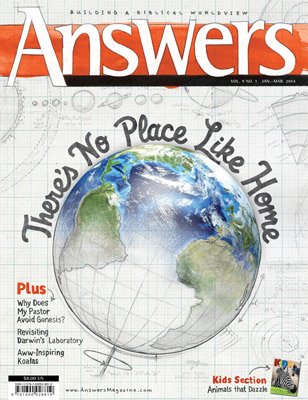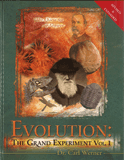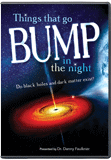Field Trip
Seeing the Field Museum with New Eyes
Sue is the largest and most complete T. rex ever discovered, and you can see her majesty at only one place—Chicago’s Field Museum. Natural history museums store some of earth’s greatest treasures, so it’d be a mistake to avoid them altogether just because they get their story wrong. You need to bring a different set of eyes!
Inspired by ancient Greek temples, the stately architecture of Chicago’s Field Museum never ceases to awe visitors. As the magazine team looked up its long flight of steps, we eagerly anticipated our day. We had come to explore the labyrinth of displays inside the Evolving Planet hall. Our goal was to help readers understand how to understand these exhibits—and similar ones at other museums—in terms of creation.
My mind raced back to the last time I stood here, as a college student. I was doing research for a freshman biology class, ironically titled “Problems in Evolution.” Having known Christ only a few months, I had no idea how to make sense of all these fossil exhibits, whose signs promoted evolution over millions of years. It was bewildering.
This time I had a completely different perspective. By God’s grace, I’ve had the privilege of working with many of the world’s leading creation experts during my years developing the Creation Museum’s content and editing Answers magazine.
The more I learn, the more I grow to enjoy natural history museums. They’re not just research projects anymore, but chances to show others how powerfully God’s Word makes sense of our world.
The Basic Plan
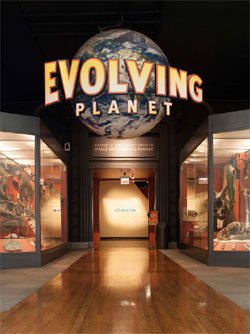
Entry to the Evolving Planet
Before you go, you need to understand how biblical history relates to the geologic column that you see in secular displays.
In one way or another, all natural history museums use the geologic column as their frame of reference. The Field Museum’s Evolving Planet takes visitors on a walk through their interpretation of history, beginning with the earth’s origin and moving through all the successive fossil layers.
Creationists do a similar thing. We have the same facts as evolutionists—the same fossils and rock layers—but we disagree about the interpretation of their past.
One simple principle will revolutionize how you see these museums. The Flood destroyed different places that existed at the same time and buried them at different levels in the sequence of rock layers that cover the continents. Evolutionists, in contrast, believe each different level represents a different time.
Noah’s world was similar in several ways to ours. For example, we don’t see the same plants and animals living everywhere. Instead, the globe is covered by dozens of distinct ecological communities, all living at the same time. Even though the climate contrasts were likely smaller before the Flood, it seems that an even greater variety of communities coexisted and is now on display at the natural history museum’s “zoo.”
Imagine. You can step back in time and witness the variety of creatures that covered the planet during the days of Adam, Noah, and other patriarchs. With preparation, you can march into any of these secular temples and confidently reclaim these testaments to God’s glory (Romans 1:20). Dinosaurs are only one example. All the museum’s creatures belong to biblical history, even if artists’ representations may not get every detail right. It’s up to you to recognize where to put them.
The Specifics
For creationists, the geologic column shown in the museum is divided into two parts: “the world that existed then [before the Flood]” and “the earth which is now [after the Flood]” (2 Peter 3:6–7).
The earliest exhibits at the museum—featuring extinct trilobites, pterosaurs, and dinosaurs—represent creatures that were alive when the Flood struck during Noah’s day.
The earliest exhibits at the museum—featuring extinct trilobites, pterosaurs, and dinosaurs—represent creatures that were alive when the Flood struck during Noah’s day. According to the most widely held creation model, the breakup of “the fountains of the great deep” (Genesis 7:11) unleashed surging waves that tore apart environment after environment, as the water drove inland. The animals and plants living in each environment were destroyed and buried in rapid succession.
That would explain why the fossil record has sea creatures buried first, followed by coastal and inland creatures. And that’s how you can explain the museum’s exhibits to others.
Original Earth
(Precambrian)
The Evolving Planet hallway begins by explaining the secular view of the origin of the earth and ocean, which they say required 4 billion years—90% of earth history. In contrast, the Bible says God created the earth out of nothing on Day 1, and then divided the seas from the land on Day Three of creation (Genesis 1:1–10). He made the land and sea by the power of His word.
The original foundations of the continents survive to this day. In the first room, you can see reminders that the Creator originally placed bacteria throughout the earth to harvest carbon, nitrogen, and other nutrients that plants and animals need. Without them, life would be impossible.
This is a good place to discuss the variety and special design of bacteria. These bacteria are just as complicated and varied as the ones living today. In fact, the largest display in the room shows that early bacteria were already using one of the most complex biochemical processes on the planet—photosynthesis!
The Cambrian Seas
(Cambrian, Ordovician, Silurian)
As you turn the corner into the next room, a massive three-part screen reenacts a host of strange critters scurrying across the Cambrian seafloor. This is the museum’s best reminder that pre-Flood seas were very different from today’s.
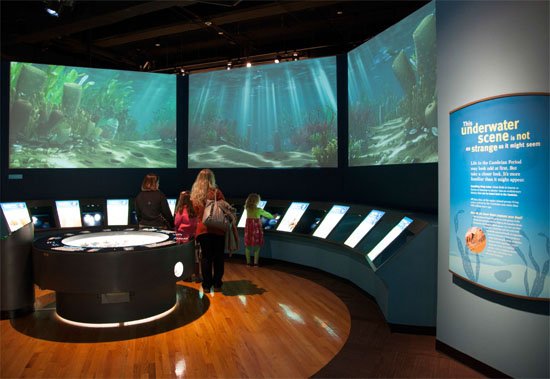
Animated scene depicting life on the Cambrian seafloor
Just as a modern aquarium displays nurse sharks, moray eels, and parrot fish swimming in a Caribbean reef, this museum lets you see trilobites and Anomalocaris (an armored predator) living on the “Cambrian” seafloor.
As you walk past the varied fossils, pay special attention to their fully functioning designs. These speak of their Creator. The very first animals in the museum—the Cambrian sea creatures—had all the same basic body plans as animals today. Indeed, they display even more variety, since many life forms (such as around 10,000 species of trilobites) apparently perished during the Flood.
The sudden appearance of all these masterful body plans—with all their parts in place and fully functioning—is a great mystery to evolutionists. But it makes sense if the Creator made all these kinds of creatures on Day Five to fill the seas with evidences of His glory.
The Cambrian is just one of several pre-Flood seafloor environments. Just as Australia’s Barrier Reef differs from the deeper waters or rocky, sandy, or muddy shores, the various parts of the Cambrian sea appear to differ from various parts of the Ordovician and Silurian. The Flood’s rising waters apparently ripped up each undersea environment in succession, burying them for our instruction today.
Swampy “Forests”
(Devonian, Carboniferous)
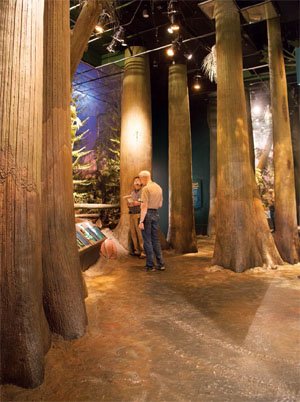
Recreation of a Carboniferous forest, based on fossils found in the Chicago area
Here’s where things get interesting. When you enter the Devonian area, the signs immediately start talking about the design of “the first plants.” But these plants aren’t anything like the ones we see today; nor are the animals. The plants’ roots, trunks, and branches were hollow, and their roots grew straight outward (not downward). The amphibian-like animals appear specially designed to live in the mud of shallow waters, not on firm ground.
The next series of rooms takes you into an environment that was apparently common before the Flood but rare today—floating mats of vegetation. Strange-looking four-legged creatures, such as the famous Tiktaalik, may have lived in the shallow waters among the roots of these plants.
This environment resembles the environments we find in swamps and quaking bogs, but on a much bigger scale and located on the ocean surface. “Devonian” plants appear to be the smaller plants likely on the outer edge of the mat, but as you move toward the center, the plants become larger. In the center were “Carboniferous” giants. The Field Museum has created a fullsize “forest” of these giants, which you walk through.
During the Flood, the waves tore apart the small exterior plants before they reached the majestic trees in the forest interior. The plant material sank and was successively buried, much of it eventually converting to coal.
Sandy Coasts
(Permian)
After walking up through the remains of past ocean environments you arrive at the coast. The pre-Flood creatures living around the sandy beaches were likely buried in the sandstone layers of the Permian and Triassic. The museum has fantastic displays parading a variety of these large creatures.
Contrary to the signs, they don’t represent new stages in evolution. Instead, it seems likely that different coastal habitats were inhabited by different kinds of specially designed animals.
Dinosaur Hall
(Triassic, Jurassic, and Cretaceous)

At the entry to the Dinosaur Hall is a fossil cast and lifelike reconstruction of a Triassic dinosaur (Herrerasaurus ischigualastensis).
The Dinosaur Hall is everyone’s favorite exhibit space at a natural history museum, and the Field Museum is no different.
Here you move into the continents’ interior. You’ll see only a handful of “Triassic” dinosaurs first. It’s not even clear whether they belonged to a different community from the near-shore Permian communities. But the next two spaces appear to represent two different locations before the Flood. Species found in Jurassic deposits, such as Allosaurus and Stegosaurus, differ markedly from the ones found in the Cretaceous, such as Tyrannosaurus and Triceratops.
You could spend the whole day here, discussing various aspects of the biblical worldview about dinosaurs. But it’s interesting that some exhibits simply elaborate on wonderful designs. The exhibit “Sauropods Were Engineered for Size,” for instance, could easily fit at the Creation Museum.
Post-Flood Recovery
(Tertiary)
In the next rooms (the Tertiary), we begin to see creatures that died in regional disasters after the Flood. Creationists disagree where to draw the line between Flood and post-Flood deposits, but at some point the exhibits start displaying the creatures that diversified and repopulated the earth after the Flood. These likely represent snapshots of successive periods after the animals left the Ark and recolonized the earth.
The variety is marvelous, yet most of the mammals look similar to the ones we see today. Camels are still camels, horses are horses, cats are cats, and so on. Creationists believe these varieties came from common parents on the Ark.
These specimens show the beautiful diversity that God placed within each created kind, and this diversity enabled creatures to fill diverse new environments in the post-Flood world.
Dawn of Humankind
One small wing is set aside for “The Dawn of Humankind.” Here the Field Museum displays four sets of bones side by side—one ape (Lucy) and three humans (Homo erectus, Neanderthal, and a modern human). The physical differences between the bodies of apes and humans are clear—and worth pointing out. Genesis 1:24–27 leaves no doubt that they were created separately.
Why do we find ape fossils below human fossils? Both humans and apes were saved on the Ark, but the apes went out from the Ark first, filling the earth and leaving fossil remains, while humans stayed behind at the Tower of Babel. Humans did not scatter until later, after God divided their languages.
Ice Age
(Quaternary)
The last exhibit area displays creatures well-suited to survive the rigors of the Ice Age. The Ice Age was a natural outcome of changing weather conditions as the earth’s climates settled down after the Flood.
Creationists acknowledge the historical reality of this era and that most of these creatures went extinct. But this period lasted only hundreds of years, not millions. The custom-made adaptations for living in the cold are evidence of the Designer, not random changes over millions of years.
The Main Point
One sobering message weighed on the magazine team, as we completed our adventure. All day we had heard children and young students chattering with their parents and teachers about their ancestors and the world before humans. Worldview is not a side issue; it colors everything.
From start to finish, the Evolving Planet exhibit hypothesizes a series of aimless changes and extinctions, with no hint of any Creator or ultimate purpose. Humans are merely a footnote.
The Bible, in contrast, identifies the Maker and Mover of earth history. It places mankind at the center of God’s plan of redemption, beginning with Adam’s creation on Day Six and his fall into sin, climaxing with Jesus Christ’s saving work on the Cross, and culminating in the new heaven and earth where God will set everything right.
God’s dealings with mankind take center stage in a biblical understanding of the fossil exhibits. Because the Creator is holy and mankind’s sin was rampant, He destroyed the world by the global Flood. Yet He offered a new beginning as the world was refilled with life. Today, God offers each of us a new beginning, which He has made possible by judging His only Son for our sins.
That message makes any trip to the Field Museum worthwhile.
A Creationist’s Walk Through the Evolving Planet Exhibit
Like most natural history museums, the Evolving Planet exhibit at Chicago’s Field Museum uses the layers of the geologic column as its framework for telling earth history. Creationists use the same sequence of rock layers, but our interpretation is much different.
Creationists believe the lower layers of the geologic column give us a picture of the pre-Flood world. The global Flood destroyed biological communities in succession, beginning with the seafloor and moving onto the continent, burying each at different levels. The topmost layers represent successive time periods in the post-Flood world, as animals recolonized the earth.
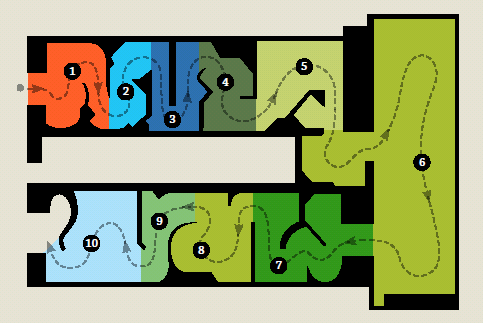
Pre-Flood World
1. Original Earth. View the rocks laid during Creation Week, before God filled the earth with animals. From the beginning, the earth had all kinds of bacteria to serve the needs of plants and animals.

2. Cambrian Sea. View the different ocean habitats during Noah’s day, filled with strange seafloor creatures like trilobites and fearsome 4-ton armored fish like Dunkleosteus.
3. & 4. Swampy “Forests.” View bizarre hollow plants and amphibian-like animals, such as Tiktaalik, which lived among the roots of bog-like mats floating on the pre-Flood ocean.
5. Sandy Coasts. View a hall full of odd four-legged creatures, such as the 6-foot (2 m) amphibian Eryops and the sail-backed Dimetrodon, which waddled across the sandy pre-Flood coasts.
6. Dinosaur Hall. View reptiles that lived in the continent’s interior. Allosaurus and Stegosaurus apparently lived in one region (Jurassic), while Tyrannosaurus and Triceratops lived elsewhere (Cretaceous).
Post-Flood World
7. & 8. Post-Flood Recovery. View creatures that died in a succession of regional disasters after the Flood. Extinct species of camels, horses, and other mammals look similar to modern species because they descended from the same original “kinds,” which God saved on the Ark.
9. & 10. Ice Age. View giant sloths, mastodons, and other amazing creatures that were well suited to survive the Ice Age, which arose briefly in the aftermath of the Flood.
Further Reading
The Basics of Natural History
- How to Read the Geologic Record
- Order in the Fossil Record
- Stumbling Stones or Stepping Stones
- Noah’s World—Same Time, Different Place
The Original Earth (Precambrian)
The Cambrian Seas (Cambrian, Ordovician, Silurian)
Swampy “Forests” (Devonian, Carboniferous)
Sandy Coasts (Permian)
Dinosaur Hall (Triassic, Jurassic, and Cretaceous)
- Noah’s World—Same Time, Different Place
- Did Dinosaurs Turn into Birds?
- Sauropods Engineered for Size
Post-Flood Recovery (Tertiary)
- Continuing Catastrophes
- Creation’s Hidden Potential
- Forests in Antarctica After the Flood?
- Variety Within Created Kinds
Humankind
Ice Age (Quaternary)
Related Downloads
A Creationist’s Walk Through the Evolving Planet Exhibit
PDF DownloadAnswers Magazine
January – March 2014
Placed safely in our solar system’s “goldilocks zone” and engineered with the perfect balance of atmosphere, chemicals, and water, our earth was miraculously formed to be inhabited (Isaiah 45:18). This issue examines the earth’s unique suitability for life. We’ll also investigate what seminaries are actually teaching our pastors, the possibility that viruses could be beneficial, and more.
Browse Issue SubscribeRecommended Resources

Answers in Genesis is an apologetics ministry, dedicated to helping Christians defend their faith and proclaim the good news of Jesus Christ.
- Customer Service 800.778.3390
- © 2024 Answers in Genesis



